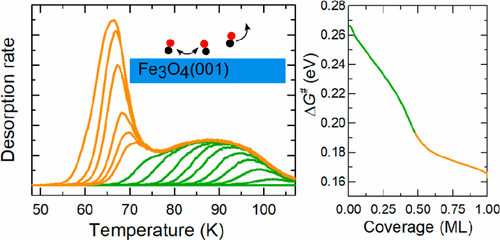当前位置:
X-MOL 学术
›
J. Phys. Chem. B
›
论文详情
Our official English website, www.x-mol.net, welcomes your
feedback! (Note: you will need to create a separate account there.)
Adsorption of CO on the Fe3O4(001) Surface
The Journal of Physical Chemistry B ( IF 2.8 ) Pub Date : 2017-09-22 00:00:00 , DOI: 10.1021/acs.jpcb.7b06349 Jan Hulva 1 , Zdeněk Jakub 1 , Zbynek Novotny 1 , Niclas Johansson 2 , Jan Knudsen 2, 3 , Joachim Schnadt 2 , Michael Schmid 1 , Ulrike Diebold 1 , Gareth S. Parkinson 1
The Journal of Physical Chemistry B ( IF 2.8 ) Pub Date : 2017-09-22 00:00:00 , DOI: 10.1021/acs.jpcb.7b06349 Jan Hulva 1 , Zdeněk Jakub 1 , Zbynek Novotny 1 , Niclas Johansson 2 , Jan Knudsen 2, 3 , Joachim Schnadt 2 , Michael Schmid 1 , Ulrike Diebold 1 , Gareth S. Parkinson 1
Affiliation

|
The interaction of CO with the Fe3O4(001)-(√2 × √2)R45° surface was studied using temperature-programmed desorption (TPD), scanning tunneling microscopy (STM), and X-ray photoelectron spectroscopy (XPS), the latter both under ultrahigh vacuum (UHV) conditions and in CO pressures up to 1 mbar. In general, the CO–Fe3O4 interaction is found to be weak. The strongest adsorption occurs at surface defects, leading to small TPD peaks at 115, 130, and 190 K. Desorption from the regular surface occurs in two distinct regimes. For coverages up to two CO molecules per (√2 × √2)R45° unit cell, the desorption maximum shows a large shift with increasing coverage, from initially 105 to 70 K. For coverages between 2 and 4 molecules per (√2 × √2)R45° unit cell, a much sharper desorption feature emerges at ∼65 K. Thermodynamic analysis of the TPD data suggests a phase transition from a dilute 2D gas into an ordered overlayer with CO molecules bound to surface Fe3+ sites. XPS data acquired at 45 K in UHV are consistent with physisorption. Some carbon-containing species are observed in the near-ambient-pressure XPS experiments at room temperature but are attributed to contamination and/or reaction with CO with water from the residual gas. No evidence was found for surface reduction or carburization by CO molecules.
中文翻译:

CO在Fe 3 O 4(001)表面上的吸附
使用程序升温脱附(TPD),扫描隧道显微镜(STM)和X射线光电子能谱(XPS)研究了CO与Fe 3 O 4(001)-(√2×√2)R45°表面的相互作用),后者在超高真空(UHV)条件下以及最高1 mbar的CO压力下均如此。通常,CO–Fe 3 O 4互动很弱。最强的吸附发生在表面缺陷处,导致在115、130和190 K处出现较小的TPD峰。从规则表面解吸发生在两种不同的状态下。对于每个(√2×√2)R45°晶胞最多覆盖两个CO分子,解吸最大值随覆盖率的增加而发生较大变化,从最初的105到70K。对于每个(√2× √2)R45°晶胞,在约65 K处出现更清晰的解吸特征。TPD数据的热力学分析表明,相从稀2D气体到有序覆盖层的相变,CO分子键合到表面Fe 3+网站。在特高压中以45 K采集的XPS数据与物理吸附一致。在室温下,在接近环境压力的XPS实验中观察到一些含碳物质,但归因于污染物和/或与残留气体中的水与CO反应。没有发现CO分子表面还原或渗碳的证据。
更新日期:2017-09-23
中文翻译:

CO在Fe 3 O 4(001)表面上的吸附
使用程序升温脱附(TPD),扫描隧道显微镜(STM)和X射线光电子能谱(XPS)研究了CO与Fe 3 O 4(001)-(√2×√2)R45°表面的相互作用),后者在超高真空(UHV)条件下以及最高1 mbar的CO压力下均如此。通常,CO–Fe 3 O 4互动很弱。最强的吸附发生在表面缺陷处,导致在115、130和190 K处出现较小的TPD峰。从规则表面解吸发生在两种不同的状态下。对于每个(√2×√2)R45°晶胞最多覆盖两个CO分子,解吸最大值随覆盖率的增加而发生较大变化,从最初的105到70K。对于每个(√2× √2)R45°晶胞,在约65 K处出现更清晰的解吸特征。TPD数据的热力学分析表明,相从稀2D气体到有序覆盖层的相变,CO分子键合到表面Fe 3+网站。在特高压中以45 K采集的XPS数据与物理吸附一致。在室温下,在接近环境压力的XPS实验中观察到一些含碳物质,但归因于污染物和/或与残留气体中的水与CO反应。没有发现CO分子表面还原或渗碳的证据。











































 京公网安备 11010802027423号
京公网安备 11010802027423号